If you’re planning a long-distance kayak expedition, it’s essential to prioritize your paddling health. Kayaking can be a physically demanding activity, and injuries can occur if you’re not adequately prepared. That’s why carrying a well-stocked first aid kit is crucial for any kayaker.
First aid kits can help you treat minor injuries, manage pain, and prevent more severe medical issues from escalating. Moreover, being well-equipped with proper outdoor safety gear can enhance your confidence and help you tackle the challenges of paddling with ease.
Whether you’re a seasoned kayaker or a beginner, never underestimate the importance of having a first aid kit on board. Read on to learn more about how first aid kits can help you safeguard your paddling health and stay safe while exploring nature.
Key Takeaways
- First Aid Kits are essential for maintaining paddling health during long-distance kayak expeditions.
- Carrying a well-stocked first aid kit and proper outdoor safety gear can help you treat minor injuries, manage pain, and prevent more severe medical issues.
- Being well-equipped can enhance your confidence and help you tackle the challenges of paddling with ease.
The Importance of Paddling Health on Long-Distance Kayak Expeditions
Embarking on long-distance kayak expeditions requires not only physical endurance and strength, but also a keen awareness of the importance of paddling health. Paddlers must be able to recognize the physical demands of kayaking and the potential risks and injuries that can occur.
Kayaking on long-distance expeditions can put a lot of strain on the body, especially the upper body, arms, and shoulders. Paddlers must ensure that they have the right technique, form, and posture to avoid injuries. Poor technique and posture can lead to repetitive strain injuries, which can be debilitating.
Moreover, kayakers are exposed to the elements, such as sun, wind, and cold water, which can cause dehydration, sunburn, hypothermia, and other health issues. Paddlers must be equipped with the right gear, such as protective clothing, sunscreen, and hydration systems, to prevent these problems.
Despite taking precautions, accidents and injuries can still happen on a kayak expedition. This is where kayaking first aid becomes vital. Kayakers must be prepared to treat injuries such as cuts, bruises, strains, and sprains. In some cases, more serious medical attention may be required, and kayakers must be able to provide basic first aid until help arrives.
Therefore, it is essential that paddlers have a well-stocked and waterproof first aid kit on their kayak expeditions. This kit should include essential items such as bandages, antiseptics, pain relievers, and emergency signaling devices. Properly stocked first aid kits can make a significant difference in treating injuries and reducing the risk of complications.
Kayakers must prioritize their paddling health when embarking on long-distance expeditions. By understanding the importance of maintaining good health, staying equipped with the right gear, and being prepared for emergencies with first aid kits, kayakers can ensure a safe and enjoyable experience.
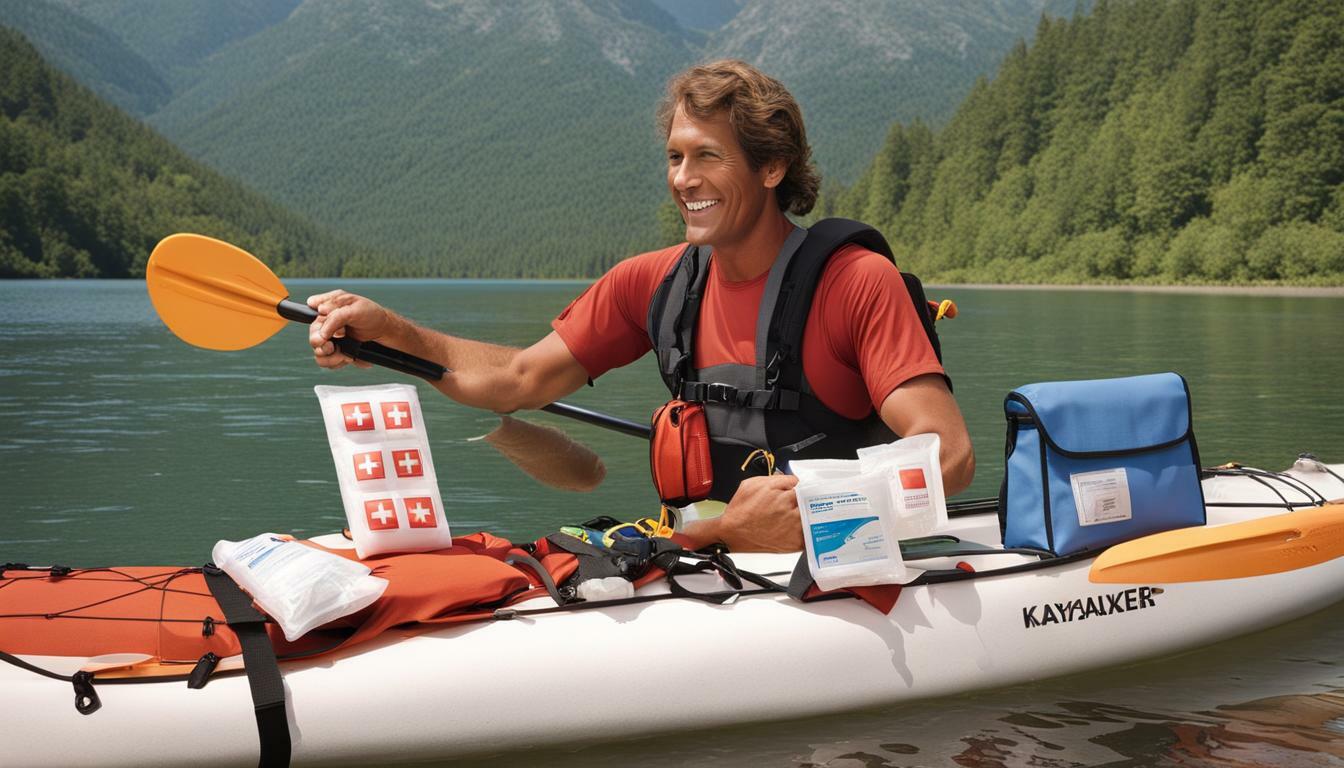
Essential Gear for Kayak Expeditions: First Aid Kits
When embarking on a long-distance kayak expedition, it is crucial to carry a well-stocked and waterproof first aid kit. Accidents can happen at any time, and kayaking can put a person at risk of injury from exposure to the elements, dehydration, and falls. The right first aid kit can help kayakers treat minor injuries and prevent them from becoming more serious.
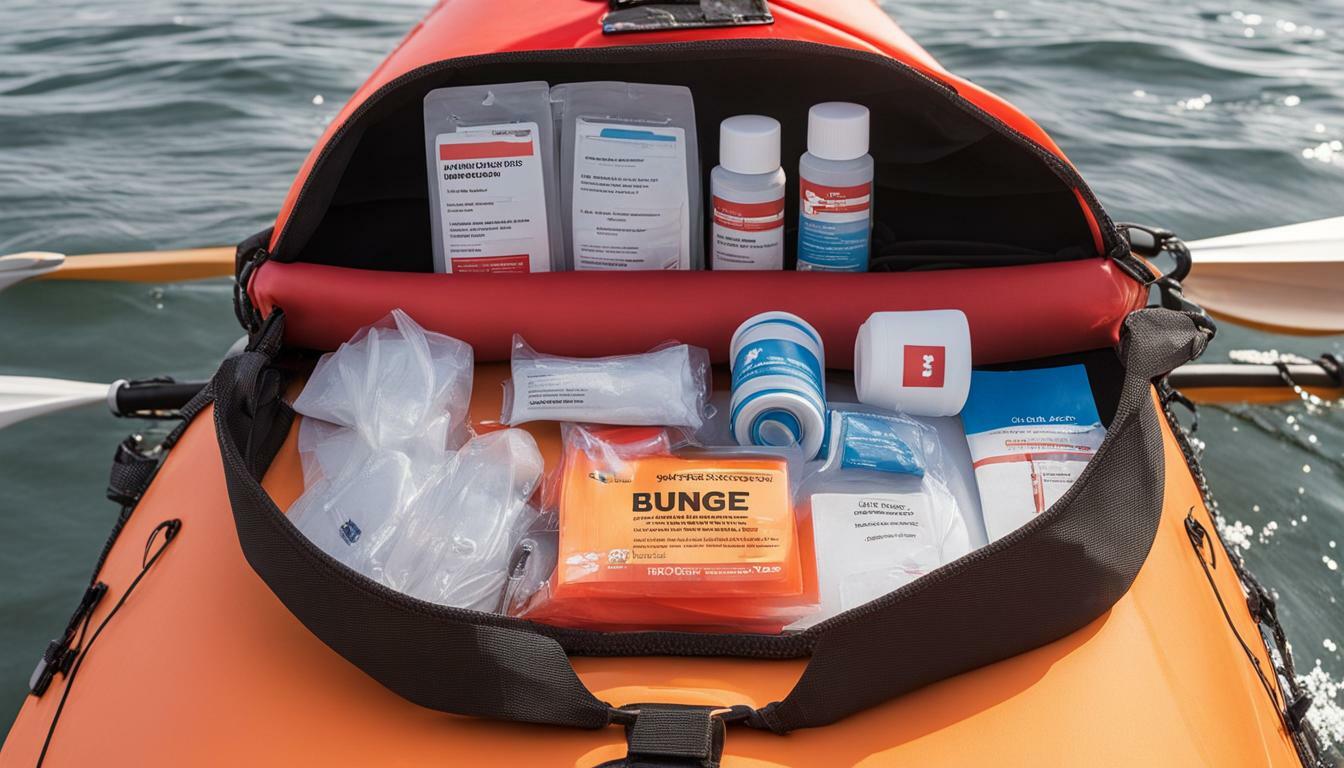
First aid kits for long-distance kayak expeditions should contain essential items such as bandages, antiseptics, pain relievers, and emergency signaling devices. In addition, it is important to include outdoor safety equipment in the kit, such as a whistle, flashlight, and space blanket.
When selecting a first aid kit, it is crucial to choose one with waterproof supplies and packaging to protect the contents from water damage. It is also important to consider the size of the kit, as well as the number of people in the group and the duration of the trip. A larger group or longer trip may require a more extensive kit with additional supplies.
Remember that not all first aid kits are created equal. Some kits are specifically designed for water-based activities and contain supplies such as waterproof adhesive bandages and salt tablets to prevent dehydration. It is important to look for a kit that meets the specific needs of your kayaking expedition.
Wilderness First Aid: Special Considerations for Kayakers
Embarking on a long-distance kayak expedition can be a thrilling adventure, but it also comes with certain risks and challenges, especially when it comes to remote and wilderness settings. Kayakers need to be prepared for emergencies, and this requires special considerations in terms of first aid and medical supplies.
Wilderness first aid is a specialized branch of emergency medical care that focuses on providing medical assistance in remote and challenging environments. It requires a unique set of skills and knowledge that go beyond traditional first aid practices.
When it comes to water sports, water sports first aid is also a crucial aspect to consider. Kayakers are exposed to different risks and injuries that require specific training and equipment.
Some of the common injuries kayakers may encounter on wilderness expeditions include:
| Injury | Description |
|---|---|
| Hypothermia | A decrease in body temperature due to exposure to cold water or air |
| Cuts and scrapes | Wounds caused by sharp objects or rough surfaces |
| Fractures and sprains | Broken or twisted bones due to falls or accidents |
| Dehydration | A lack of fluids in the body due to prolonged exposure without access to drinking water |
To ensure the safety of kayakers, wilderness first aid training and equipment are essential. Kayakers should consider taking a wilderness first aid course to learn how to deal with emergencies in remote settings. They should also carry a well-stocked first aid kit that includes specific items for water sports injuries, such as waterproof bandages, antiseptics, and pain relievers.

Having a personalized first aid plan is also important. Kayakers should assess their individual medical needs, understand the environment they will be kayaking in, and prepare for potential emergencies. Staying safe on a long-distance kayak expedition requires careful planning, preparation, and attention to detail.
Injury Prevention for Paddlers: Tips and Techniques
As with any physical activity, injury prevention is a crucial part of maintaining paddling health on long-distance kayak expeditions. Here are some tips and techniques to ensure that you stay injury-free.
Warm Up With Stretching Exercises
Before hitting the water, spend a few minutes warming up your muscles with some stretching exercises. Focus on your arms, shoulders, back, and core, as these are the areas that are most heavily worked during kayaking. Start gently and gradually increase the intensity of your stretches.
Maintain Proper Posture and Form
Good posture and proper form are essential for preventing injury while paddling. Keep your back straight and engage your core muscles to avoid slouching. Use your legs to drive your movements and avoid rotating your torso too much.
Use Protective Gear
Wearing proper protective gear can help prevent injuries. Wear a well-fitted personal flotation device (PFD) at all times while on the water. Consider wearing gloves to protect your hands from blisters and calluses, and invest in a helmet if you plan to kayak in rougher waters.
Take Breaks and Stay Hydrated
Remember to take regular breaks and drink plenty of fluids to stay hydrated. Paddling requires a lot of physical exertion, and it’s easy to become dehydrated without realizing it. Take the opportunity to stretch and rest your muscles during breaks.
Know Your Limits
Be honest with yourself about your limitations and avoid pushing yourself too hard. Kayaking should be an enjoyable experience, not an endurance test. If you’re feeling tired or uncomfortable, take a break and reassess your situation.
By following these injury prevention tips and techniques, you can ensure that you stay healthy and injury-free while paddling on long-distance kayak expeditions.
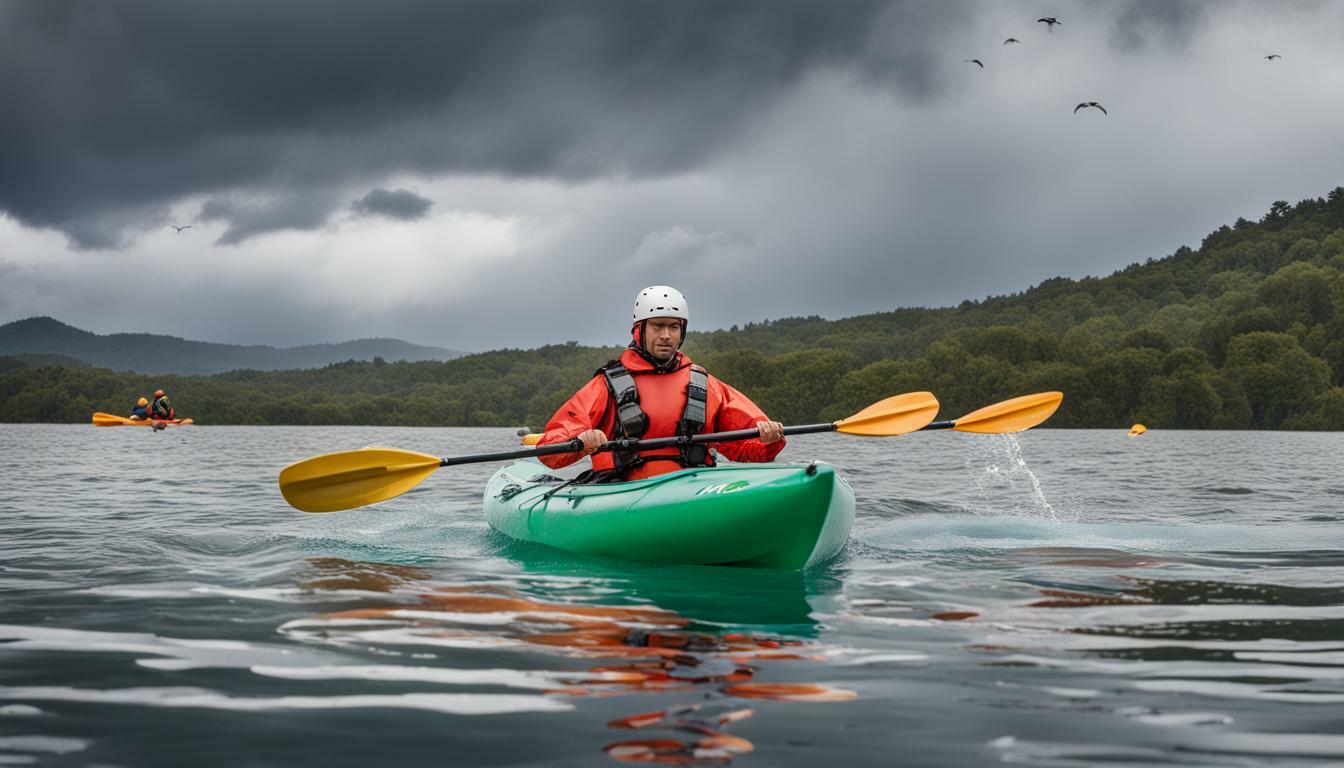
The Role of Emergency Medical Supplies in First Aid Kits
When embarking on a long-distance kayak expedition, carrying a well-stocked first aid kit is essential for ensuring your safety and wellbeing. To be fully prepared for any emergency situations, it is important to include emergency medical supplies in your kit.
Emergency medical supplies are specially designed to provide immediate care in critical situations and can be the difference between life and death. These supplies include a range of items such as bandages, antiseptics, pain relievers, and emergency signaling devices.
Bandages are essential for controlling bleeding and preventing infection. It is important to include a variety of bandages such as sterile gauze pads, adhesive bandages, and elastic wraps to cater to different types of injuries. Antiseptics such as iodine and alcohol swabs are important for cleaning wounds and preventing infection. Pain relievers such as paracetamol and ibuprofen can help to alleviate pain and discomfort in the event of an injury.
Emergency signaling devices such as whistles and flares can be used to attract attention and summon help in case of an emergency. A whistle, for example, can be heard from a distance and can help rescuers locate you even if you are out of sight.
It is important to store all emergency medical supplies in a waterproof container to protect them from moisture and ensure they remain in good condition. This will help to ensure that these supplies are always available and ready for use during an emergency.
Remember, emergencies can happen anywhere and at any time. By including emergency medical supplies in your first aid kit, you can stay prepared for any situation and ensure your safety and wellbeing while kayaking.
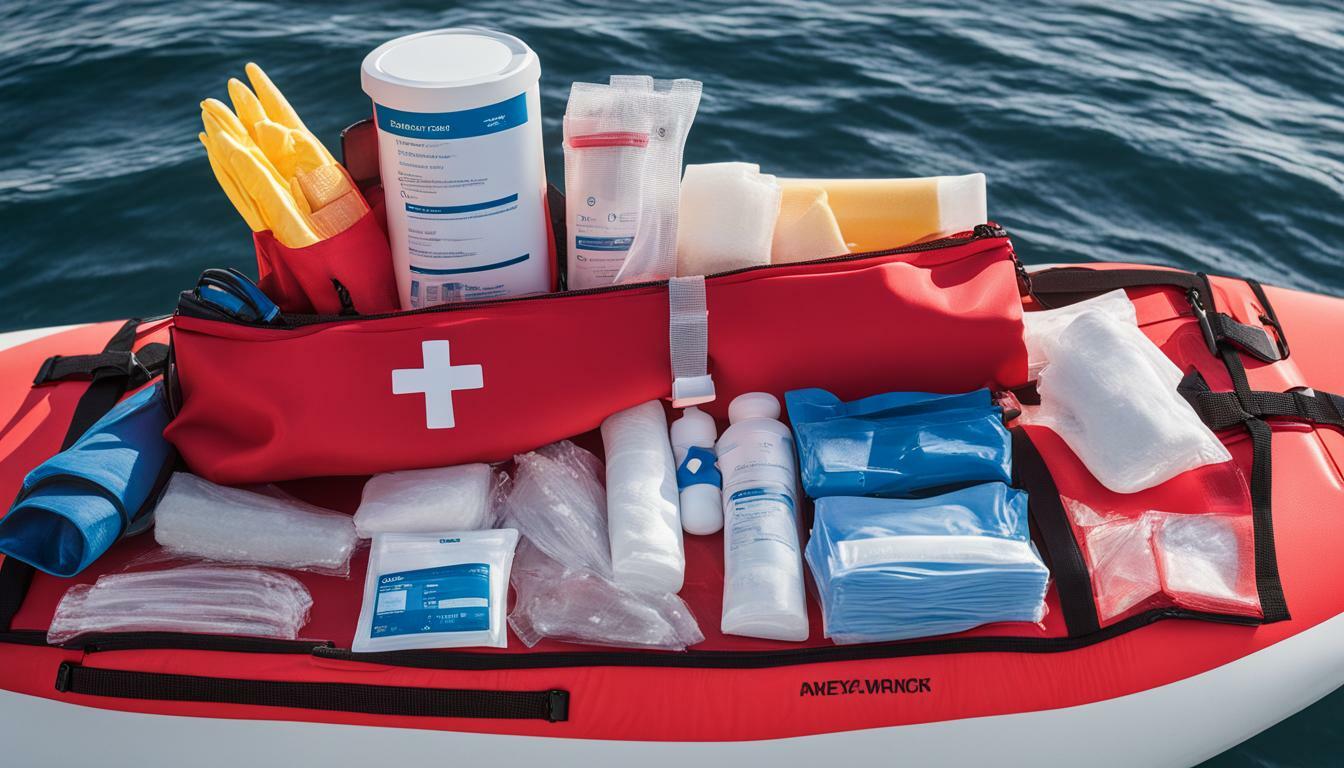
Navigating UK Waterways: Stay Prepared and Safe
When kayaking in the UK, it’s important to be prepared and safe. The UK has a variety of waterways, each with its own set of regulations and potential hazards. Whether you’re paddling across a lake or navigating a river, you need to be aware of your surroundings and equipped with the right gear, including a first aid kit.
The first step to being prepared is understanding the waterways you’ll be paddling. The Canal & River Trust provides information on UK waterways, including navigation guides, safety tips, and updates on any closures or restrictions. It’s also important to check weather conditions and water levels before setting off.
When kayaking in the UK, you should always carry a well-stocked first aid kit. A waterproof first aid kit is essential for any water sport, as it ensures that your supplies will be protected from water damage. Your kit should also include outdoor safety equipment, such as a whistle, compass, and waterproof matches.
| Essential items for a first aid kit for UK waterways: | |
|---|---|
| Waterproof bandages and dressings | ✓ |
| Antiseptic wipes | ✓ |
| Pain relief medication | ✓ |
| Tweezers for removing splinters or ticks | ✓ |
| Emergency blanket | ✓ |
| Whistle for signaling for help | ✓ |
| Waterproof matches | ✓ |
| Compass | ✓ |
It’s also important to be aware of the potential risks and injuries that can occur while kayaking in the UK. Hypothermia, a condition caused by prolonged exposure to cold water, is a common risk for paddlers. Wearing appropriate clothing and avoiding cotton can help prevent hypothermia.
Other injuries, such as cuts, sprains, and strains, can also occur. Proper technique, including maintaining good posture and using your core muscles, can help prevent these types of injuries. Additionally, stretching before and after paddling can help prevent muscle soreness and injury.
By staying prepared and aware of the potential risks and injuries, you can ensure a safe and enjoyable kayaking experience on UK waterways. Remember to always carry a well-stocked first aid kit and outdoor safety equipment, and to be familiar with the navigation guides and safety tips provided by the Canal & River Trust.
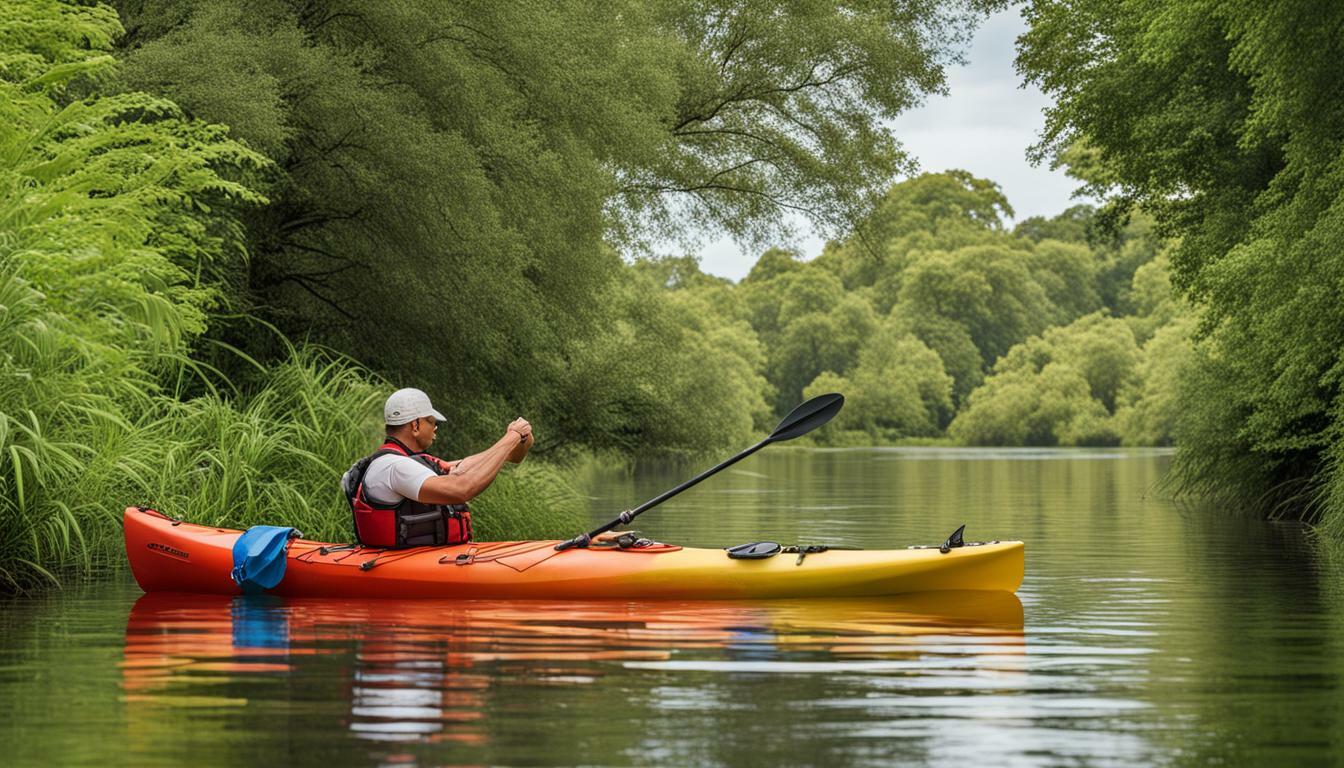
Assessing and Treating Common Kayaking Injuries
While kayaking is an enjoyable and exhilarating activity, it can also pose some risks and lead to various types of injuries. Knowing how to assess and treat common kayaking injuries is crucial for ensuring the safety and well-being of all involved. Here are some useful guidelines to keep in mind:
Sprains and Strains
Sprains and strains are common kayaking injuries that can result from overuse, sudden movements, or accidents. Symptoms include pain, swelling, and restricted movement. To assess the injury, check for tenderness, bruising, and range of motion. For mild sprains or strains, rest, ice, compression, and elevation (RICE) can help reduce swelling and promote healing. More severe injuries may require medical attention.
Cuts and Abrasions
Cuts and abrasions can occur while kayaking, particularly when navigating rapids or rocky areas. To assess the injury, clean the wound thoroughly and check for signs of infection such as redness, swelling, or severe pain. Cover the wound with sterile dressing and apply pressure if bleeding is heavy. Seek medical attention for deeper cuts that may require stitches.
Hypothermia
Hypothermia is a serious condition that can occur when the body loses heat faster than it can produce it, usually in cold water or air. Symptoms include shivering, fatigue, confusion, and loss of coordination. To assess the injury, check for a low body temperature and provide warmth by changing into dry clothing, using blankets or sleeping bags, and drinking warm fluids. Seek medical attention if symptoms persist or worsen.
When kayaking in remote or wilderness areas, it is important to have knowledge of wilderness first aid. This includes knowing how to assess and treat common injuries, as well as understanding how to use emergency signals to call for help in case of severe injuries or emergencies. By being prepared and vigilant, kayakers can enjoy their expeditions safely and with confidence.

Choosing the Right First Aid Kit for Kayak Expeditions
When planning for a long-distance kayak expedition, it is crucial to have the right gear, including a well-stocked first aid kit. However, with so many options available in the market, it can be overwhelming to decide which one to choose. Here are some essential factors to consider when selecting the right first aid kit for your kayak trip:
| Factors to Consider | Details to Keep in Mind |
|---|---|
| Duration of the Trip | The length of your journey will determine the quantity of supplies you need to carry. For longer trips, it is essential to have a kit with sufficient supplies to last the entire journey. |
| Group Size | If you are traveling with a group, ensure that the kit has enough supplies to cater to everyone’s needs. Consider carrying extra supplies to account for emergencies. |
| Specific Needs | If you or any of your group members have pre-existing medical conditions or allergies, make sure the first aid kit has the necessary supplies to address them. |
| Waterproofing | As kayaking involves exposure to water, it is essential to ensure that the first aid kit is waterproof to protect the supplies from getting damaged. |
When selecting a first aid kit, it is important to think about your individual requirements. It is also advisable to purchase a pre-packaged kit that contains most of the essential items. Additionally, consider including outdoor safety equipment such as a whistle, flashlight, and emergency blanket.
Carrying a well-stocked and appropriate first aid kit is crucial for any kayak expedition. It can help safeguard against injuries and reduce the risk of complications. Take the time to select the right kit for you, and ensure that you have everything you need for a safe and enjoyable trip.
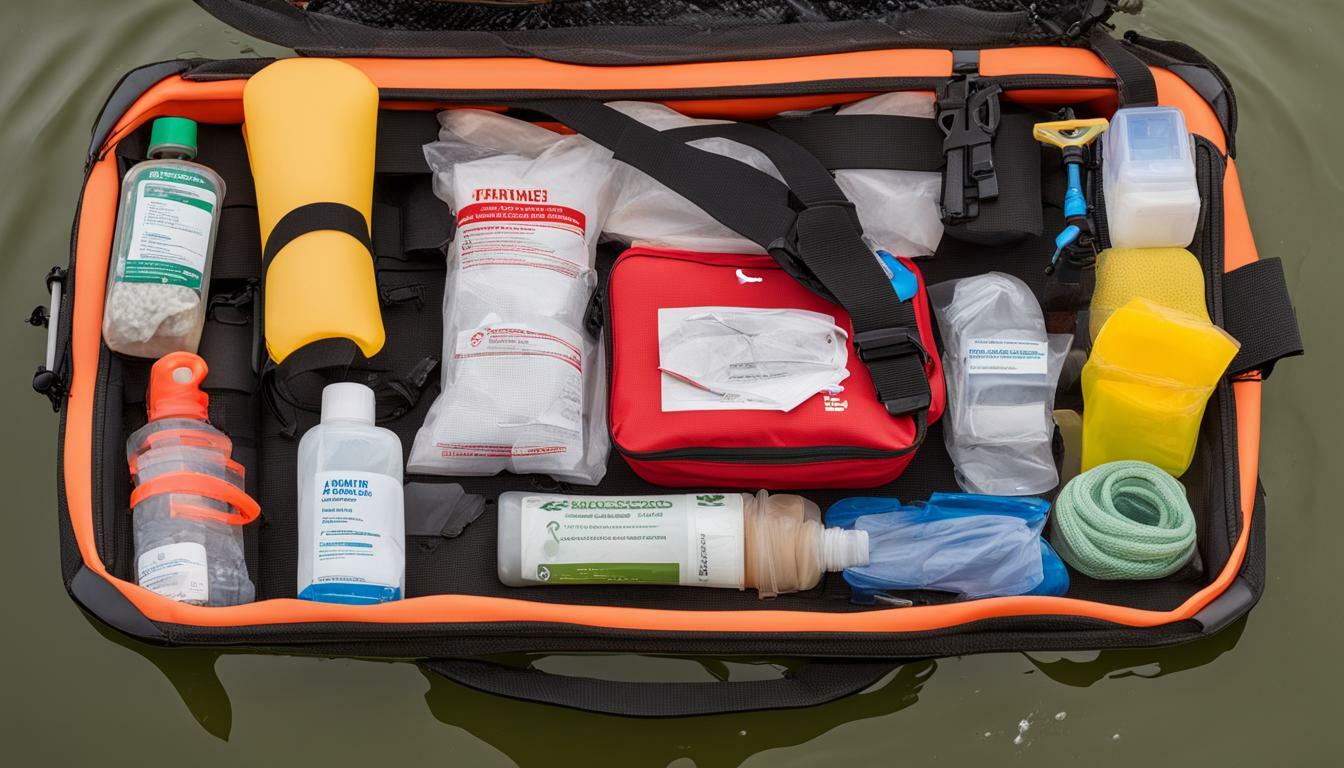
Staying Prepared for Emergencies: Creating a Personalized First Aid Plan
When heading out on a kayak expedition, it’s crucial to have a personalized first aid plan in place. This plan should take into account individual medical needs, trip duration, group size, and potential emergencies. Here are some important steps to follow when creating a first aid plan for your kayak expedition.
Assess Individual Medical Needs
Before embarking on a kayak expedition, it’s essential to assess individual medical needs. This includes taking into account any pre-existing medical conditions, allergies, or medication requirements. Ensure that any necessary medication is packed in a waterproof container, along with a copy of prescriptions and medical information. This will help in case of an emergency and will also make medical treatment more effective.
Understand Your Environment
Understanding the environment where you will be kayaking is crucial when creating a first aid plan. Research the weather conditions, water temperatures, and potential hazards such as rocks, strong currents, or wildlife. This will help you to pack the appropriate gear and first aid supplies needed to handle emergencies that might arise.
Prepare for Emergencies
When planning your first aid kit, ensure you have enough emergency medical supplies to handle various scenarios. Essential gear for kayak expeditions includes waterproof first aid supplies, outdoor safety equipment, and a waterproof emergency signaling device. Some of the critical supplies include bandages, antiseptics, pain relievers, and emergency blankets.
Be Safe and Prepared with the Right Gear
To stay safe and prepared on your kayak expedition, remember to pack the right gear. In addition to a well-stocked first aid kit, it’s essential to have other gear such as a life jacket, wet suit, and a helmet. These items will help you to stay safe and protected while paddling on the water.
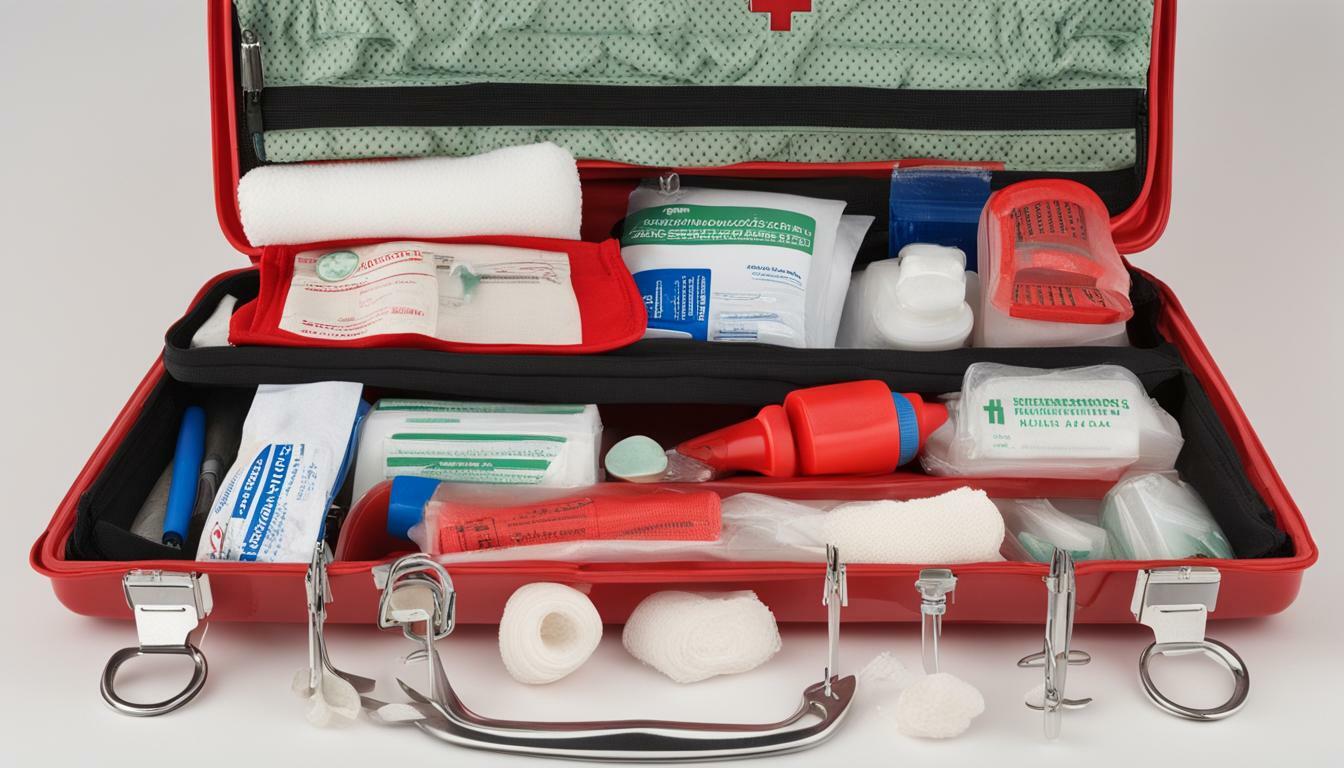
When planning your personalized first aid plan, it’s essential to take into account individual medical needs, understand the environment, and prepare emergency medical supplies and gear. Having a well-thought-out plan and the right gear can help to ensure a safe and enjoyable kayaking experience.
Conclusion
In conclusion, maintaining paddling health during long-distance kayak expeditions is crucial for a safe and enjoyable experience. As highlighted in this article, first aid kits play a significant role in safeguarding the well-being of kayakers.
From carrying waterproof first aid supplies to including outdoor safety equipment, there are several essential gears required for kayak expeditions. Additionally, kayakers should be aware of the unique challenges they face in remote and wilderness settings, emphasizing the importance of wilderness first aid training.
To prevent injuries, paddlers should follow proper warm-up exercises, maintain proper form, and use protective gear. In case of emergencies, having emergency medical supplies in the first aid kit is crucial.
When choosing a first aid kit, kayakers should consider factors such as trip duration, group size, and specific needs. Creating a personalized first aid plan is also an essential step in staying prepared for emergencies.
Be prepared in the UK waterways
If you plan to kayak in the UK, it is essential to be aware of the different regulations and waterways. By carrying appropriate first aid kits, you can stay prepared and safe during your kayak expeditions.
Overall, investing in first aid kits and wilderness first aid training can go a long way in ensuring paddling health and safety. By following the guidelines outlined in this article, kayakers can have a safe and enjoyable experience on their long-distance kayak expeditions.
